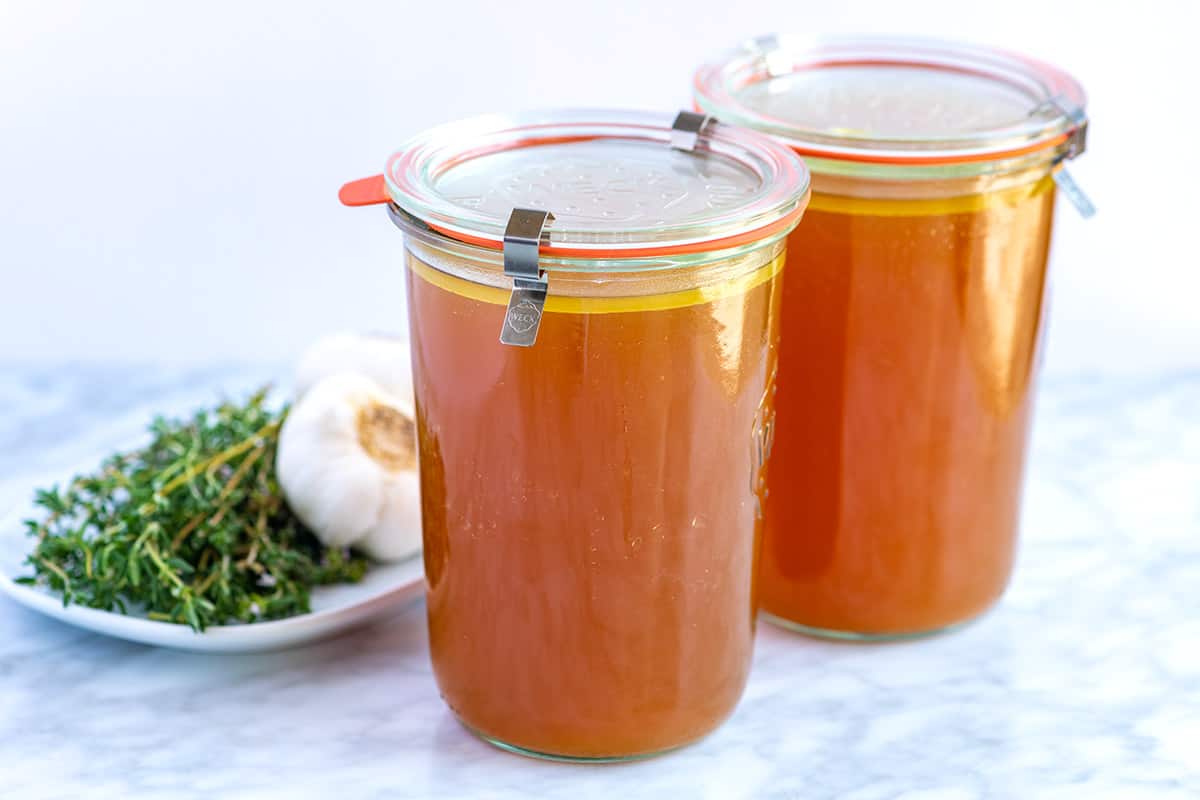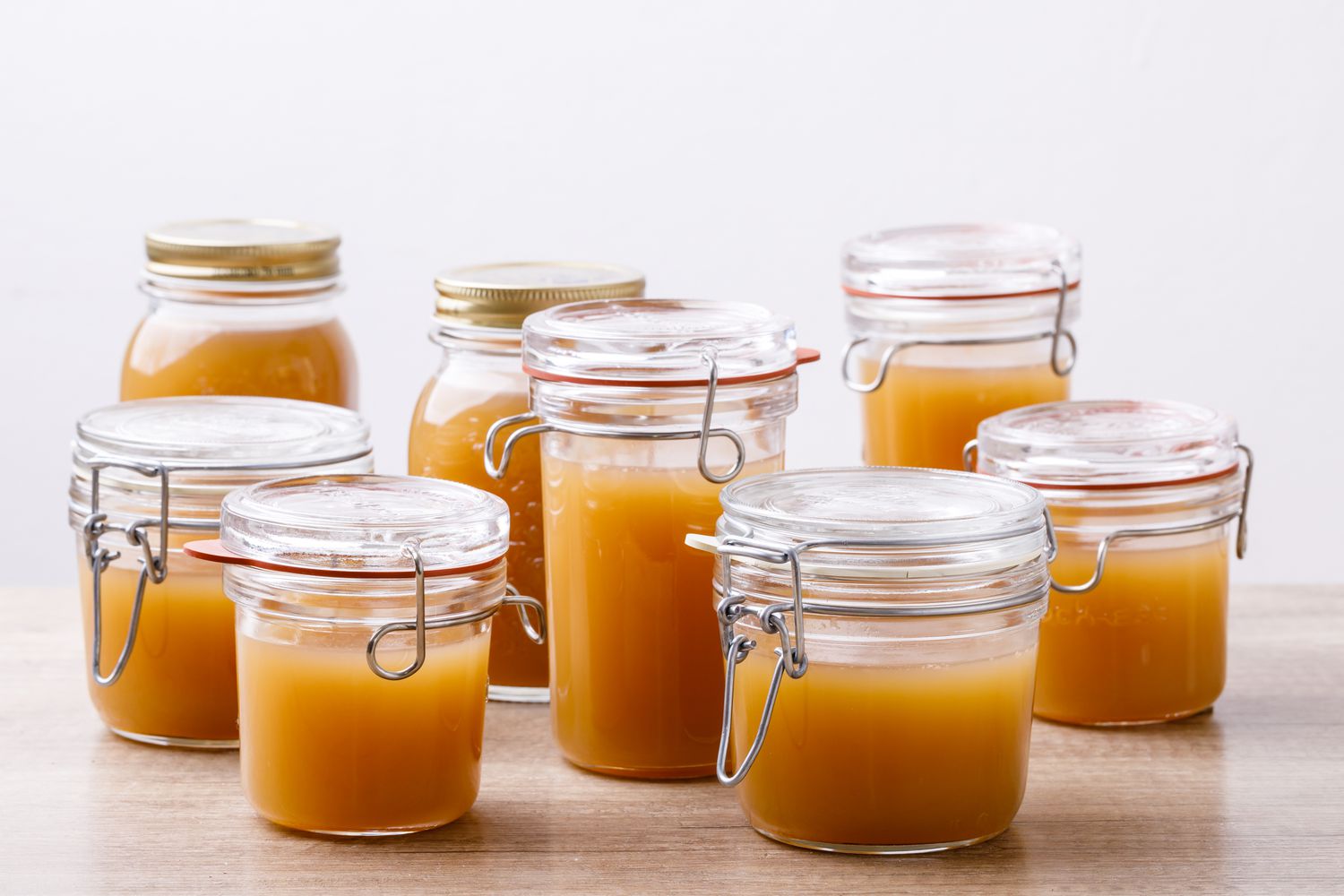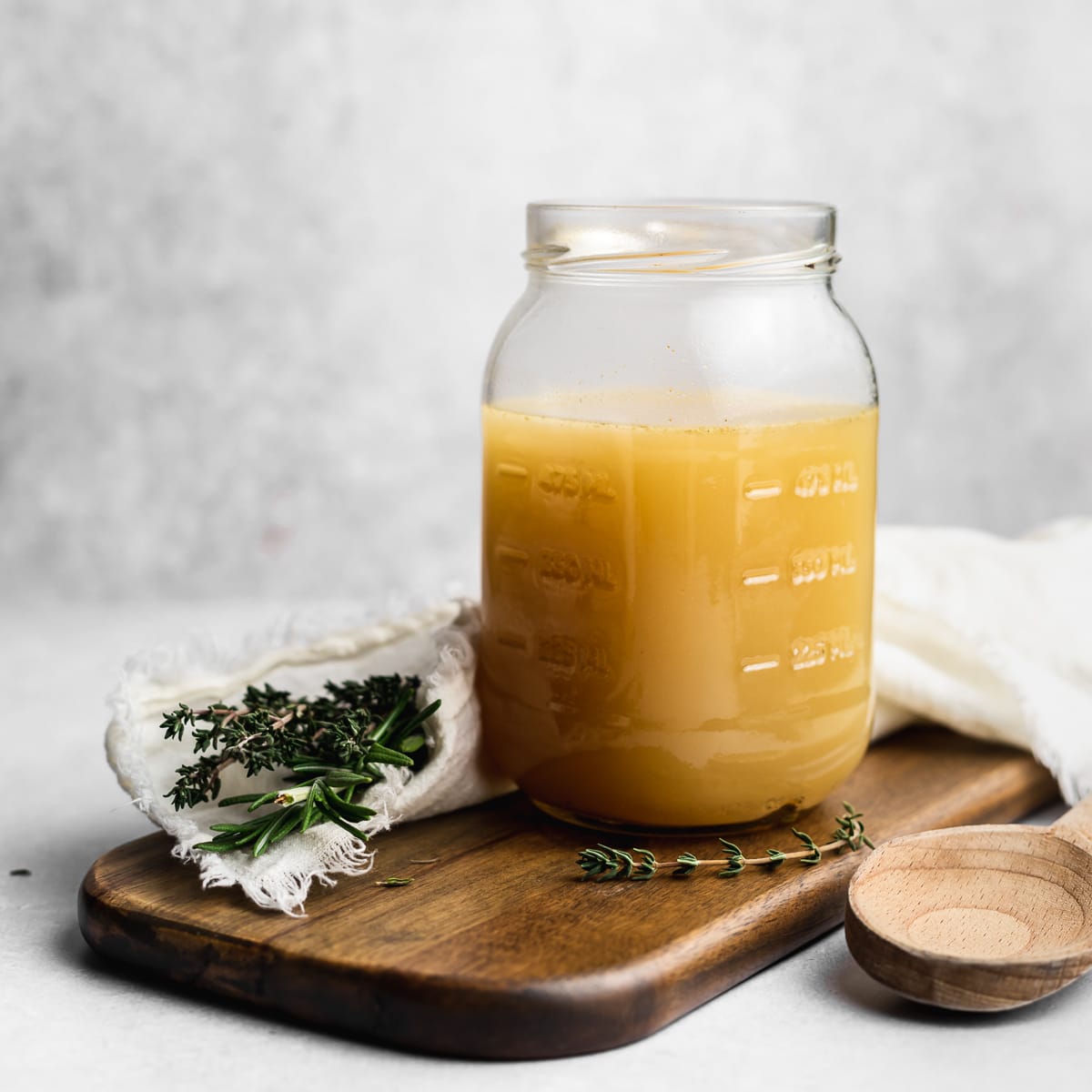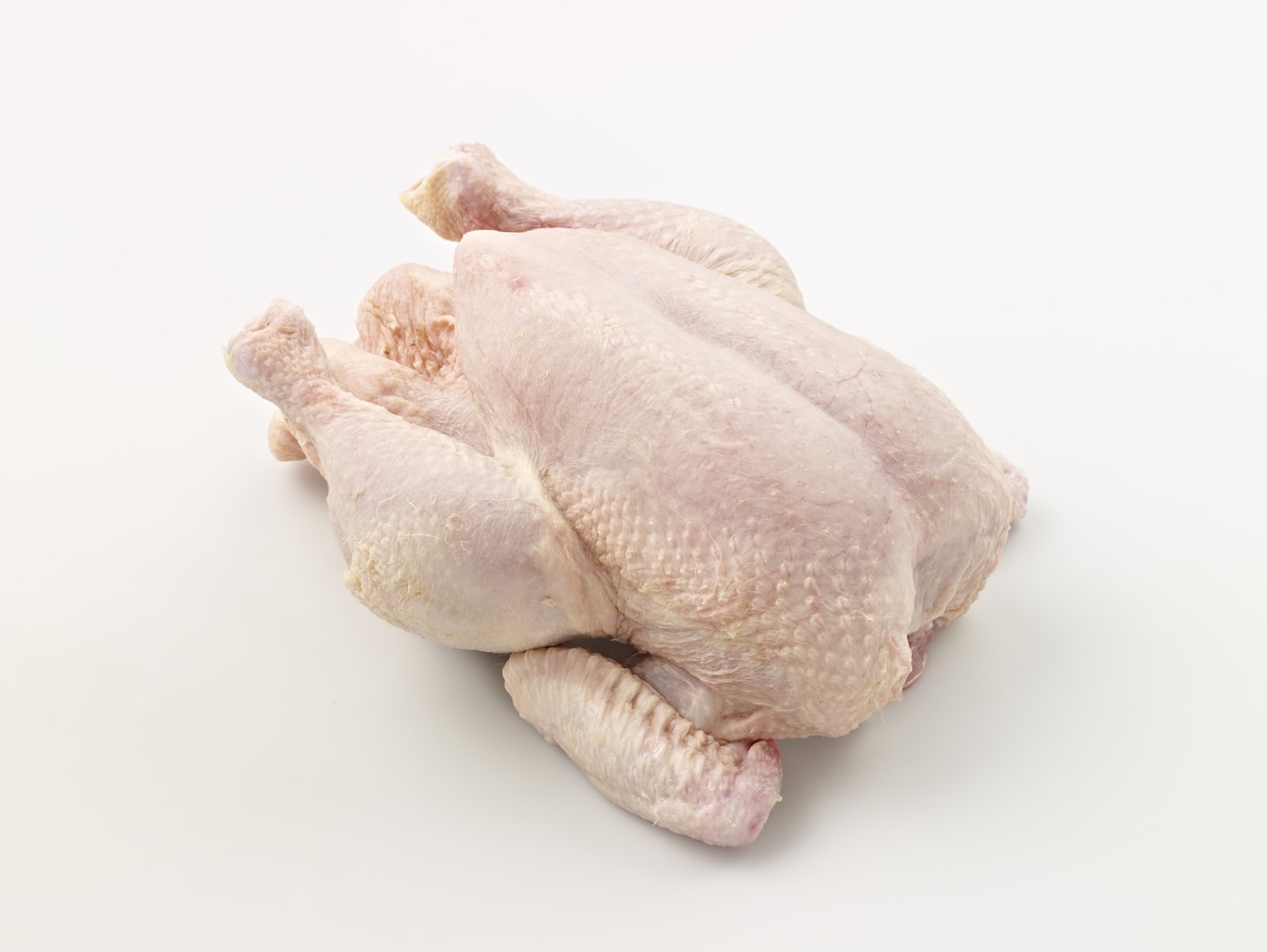

Articles
How To Store Chicken Stock
Modified: August 28, 2024
Looking for articles on how to store chicken stock? Find expert tips and guidelines to ensure your chicken stock stays fresh and flavorful.
(Many of the links in this article redirect to a specific reviewed product. Your purchase of these products through affiliate links helps to generate commission for Storables.com, at no extra cost. Learn more)
Introduction
Welcome to this guide on how to store chicken stock! Whether you’ve made a large batch from scratch or have leftover stock from a recipe, knowing how to properly store chicken stock is essential to maintaining its quality and freshness. Chicken stock is a versatile ingredient that can be used to enhance the flavor of soups, sauces, and countless other dishes. By following the right storage techniques, you can ensure that your chicken stock remains safe to consume and retains its delicious taste for an extended period of time.
Proper storage of chicken stock involves several key factors, including choosing the right containers, cooling and straining the stock, labeling and dating the containers, and determining whether to freeze or refrigerate the stock based on your anticipated usage. By understanding these steps and following some additional tips to extend the shelf life of your chicken stock, you’ll be able to enjoy its rich flavor and aroma whenever you need it.
So, let’s dive into the details and learn how to store chicken stock like a pro!
Key Takeaways:
- Properly storing chicken stock is crucial for preserving its freshness, flavor, and safety. Whether freezing or refrigerating, following the right techniques ensures delicious, ready-to-use stock for your culinary creations.
- By choosing the right containers, cooling and straining the stock, labeling and dating the containers, and practicing proper storage methods, you can extend the shelf life of your chicken stock. Whether freezing for long-term storage or refrigerating for immediate use, your stock will be ready to enhance your favorite dishes.
Read more: How To Store Homemade Stock
Importance of Proper Chicken Stock Storage
Proper storage of chicken stock is crucial for maintaining its quality, flavor, and safety. Here are a few reasons why it’s important to pay attention to how you store your chicken stock:
- Preserving Freshness: Chicken stock is made by simmering chicken bones, vegetables, herbs, and spices to extract their flavors. Without proper storage, the stock can quickly spoil and lose its fresh taste. By implementing the right storage techniques, you can extend its shelf life and ensure that it remains fresh and flavorful.
- Maintaining Food Safety: Like any perishable food product, chicken stock can harbor harmful bacteria if not stored properly. This can lead to foodborne illnesses when consumed. By following the recommended storage methods, you can minimize the risk of bacterial growth and keep your chicken stock safe for consumption.
- Convenience and Cost-Efficiency: Storing chicken stock properly allows you to have a readily available ingredient to enhance your meals. Whether you freeze it in small portions or refrigerate it for immediate use, having stock at hand saves you time and money compared to buying it frequently from the store. It also allows you to control the quality and flavor of your dishes.
By understanding the importance of proper chicken stock storage, you can take the necessary steps to ensure that your homemade or store-bought stock maintains its freshness, safety, and flavor for as long as possible.
Choosing the Right Containers for Storing Chicken Stock
When it comes to storing chicken stock, selecting the appropriate containers is crucial. The right containers will help preserve the quality of the stock and prevent any leakage or contamination. Here are a few considerations to keep in mind:
- Material: Opt for containers made of food-grade materials such as glass, stainless steel, or BPA-free plastic. These materials are non-reactive and won’t leach any harmful chemicals into your stock.
- Sealability: Look for containers with airtight seals or lids to prevent air from getting in and bacteria from contaminating the stock. This will help maintain the freshness and flavor of the stock.
- Size: Consider the quantity of stock you usually use in a recipe. Choose containers that can hold an appropriate amount of stock, allowing for easy thawing or portioning for recipes.
- Freeze-ability: If you plan to freeze the stock, ensure that the containers are freezer-safe. Mason jars, freezer bags, and plastic containers specifically designed for freezing are great options.
Additionally, it’s important to consider whether the containers are easy to clean and store. Containers with wide mouths make it easier to fill and clean, while stackable options save space in your refrigerator or freezer.
Remember, when selecting containers, always prioritize safety, functionality, and the ability to preserve the quality of your chicken stock. By using the right containers, you can maintain the freshness and taste of your stock for an extended period.
Cooling and Straining Chicken Stock
After preparing your homemade chicken stock, it’s essential to cool and strain it properly before storing. This helps eliminate any impurities and ensures the stock’s quality. Follow these steps to cool and strain your chicken stock:
- Cooling: Allow the chicken stock to cool at room temperature for about 1-2 hours before transferring it to the refrigerator or freezer. Avoid placing hot stock directly in the refrigerator, as this can raise the temperature inside and potentially spoil other perishable items.
- Skimming: While the stock is cooling, periodically skim off any fat or impurities that rise to the top. This helps improve the clarity of the stock and eliminates any undesirable flavors.
- Straining: Once the stock has cooled, strain it through a fine-mesh strainer or cheesecloth to remove any remaining solids, such as bones, herbs, and vegetables. This step ensures a smooth and clear stock that is ready for storage.
Alternatively, you can use a ladle to carefully remove the top layer of stock, leaving behind any sediment at the bottom of the pot. This method can be effective for removing impurities without the need for straining.
Once strained, transfer the chicken stock to your chosen storage containers, leaving some headspace to allow for expansion if freezing. Remember to cover the containers tightly to prevent air exposure and maintain the stock’s freshness.
By properly cooling and straining your chicken stock, you ensure that it is free from impurities and ready to be stored safely for future use.
Labeling and Dating Chicken Stock Containers
Properly labeling and dating your chicken stock containers is essential for organization and ensuring you use the oldest stock first. Here’s why it’s important and how to go about it:
- Identification: Labeling your chicken stock containers allows you to easily identify them in your refrigerator or freezer. This prevents confusion and helps you find the specific batch of stock you need without rummaging through multiple containers.
- Date of Preparation: Dating your chicken stock containers allows you to keep track of their freshness. It’s important to know when the stock was prepared, as stock typically has a shelf life of about 3-4 days in the refrigerator and 3-6 months in the freezer.
- Rotation: By labeling and dating your containers, you can practice proper stock rotation. Always use the oldest stock first to maintain its quality and prevent any wastage. This ensures that you’re always using stock within its recommended storage timeframe.
When labeling your containers, make sure to include the date of preparation and any other relevant information, such as the type of stock (e.g., chicken broth, stock, or bone broth). You can use adhesive labels, freezer-safe tape, or even write directly on the container with a permanent marker.
It’s also helpful to keep a record of the stock batches in a notebook or digital file. This allows you to easily track when each batch was prepared and consumed, ensuring that you always use your stock within the appropriate time frame.
By labeling and dating your chicken stock containers, you can stay organized, maintain freshness, and make the most out of your homemade or store-bought stock.
Store chicken stock in airtight containers or resealable plastic bags, and label with the date. It can be kept in the refrigerator for up to 4 days or frozen for up to 3 months.
Read more: How To Store Stockings
Freezing Chicken Stock
Freezing chicken stock is a convenient way to preserve it for longer periods while maintaining its quality. Here are the steps to freeze chicken stock properly:
- Cooling and Straining: Before freezing, make sure the chicken stock has cooled completely and has been strained to remove any solids. This helps maintain the stock’s texture and prevents freezer burn.
- Portioning: Divide the chicken stock into smaller portions based on your typical usage. Freezing in smaller quantities allows for easier thawing and prevents wastage. You can use ice cube trays for individual portions or larger containers for family-sized servings.
- Container Selection: Choose freezer-safe containers or bags specifically designed for freezing. Ensure they have a good seal to prevent any freezer burn or leakage. Leaving some headspace in the container allows the stock to expand during freezing.
- Labeling: Label each container with the date of freezing to keep track of its freshness and ensure proper rotation.
- Freezing: Place the filled containers in the freezer, making sure they are placed in an upright position until completely frozen. This prevents any spillage or leakage during the freezing process. Once frozen, you can stack the containers to save space.
When properly frozen, chicken stock can generally last for 3-6 months in the freezer. However, it’s always best to consume it within the first 3 months for optimal flavor and quality.
Freezing chicken stock is ideal for those times when you need a smaller amount for a recipe or when you want to extend the shelf life of your stock. It’s a convenient way to have stock readily available whenever you need it, without worry of it going bad.
When you’re ready to use the frozen chicken stock, simply thaw it in the refrigerator overnight or heat it gently on the stovetop. It’s now ready to add flavor and richness to your soups, stews, sauces, and more!
Refrigerating Chicken Stock
If you plan to use your chicken stock within a few days, refrigeration is the best option. Here’s how to store chicken stock in the refrigerator:
- Cooling: Allow the chicken stock to cool to room temperature before refrigerating. Placing hot stock directly into the refrigerator can lead to improper cooling and cause temperature fluctuations that may spoil other perishable items.
- Container Selection: Transfer the cooled chicken stock into airtight containers or jars suitable for refrigeration. Make sure the containers are clean and can seal tightly to prevent any contamination or odors from affecting the stock.
- Labeling and Dating: Label the containers with the date of preparation to keep track of its freshness. This will help you determine when it should be used or discarded based on the recommended storage time.
- Storage: Place the sealed containers of chicken stock in the refrigerator. Store them on a shelf where they won’t be disturbed, ensuring they are kept away from raw meats or other items with strong odors that could affect the stock’s taste.
- Shelf Life: Chicken stock stored in the refrigerator should be consumed within 3-4 days to maintain its quality and safety. It’s important to use it within this time frame to avoid any potential bacterial growth.
Refrigerating chicken stock is a great option when you plan to use it for a recipe within a few days or when you want to have stock readily available for immediate use. Its convenience and shorter storage time make it suitable for those who prefer to have freshly made stock on hand.
When using refrigerated chicken stock, always check for any signs of spoilage, such as an off odor, unusual color, or the presence of mold. If you notice any of these signs, it is best to discard the stock to avoid any risk of foodborne illnesses.
With proper storage in the refrigerator, your chicken stock will remain fresh and delicious, ready to enhance the flavor of your favorite culinary creations.
Tips for Extending the Shelf Life of Chicken Stock
To make the most out of your chicken stock and ensure its longevity, consider these helpful tips for extending its shelf life:
- Proper Storage Conditions: Store your chicken stock in a consistently cold environment. The refrigerator should be set to a temperature of 40°F (4°C) or below to prevent any bacterial growth. Keep the freezer at 0°F (-18°C) or lower for optimal storage conditions.
- Avoid Cross-Contamination: Store chicken stock away from raw meats or any other items that could contaminate it. Ensure sealing containers tightly and placing them on a separate shelf or compartment to prevent any potential cross-contamination.
- Regularly Refresh and Reheat: If you plan to keep refrigerated chicken stock for more than a few days, it’s advisable to bring it to a boil every 2-3 days. This helps kill off any potential bacteria and extends its shelf life.
- Don’t Mix Fresh and Used Stock: Avoid combining fresh chicken stock with leftovers from older batches, as this can reduce the overall freshness and potentially introduce contaminants. Use up the older stock before opening a new container.
- Use Clean Utensils: When scooping chicken stock from the container, always use clean utensils to prevent any contamination. Avoid using your hands or utensils that have been in contact with raw meats.
- Practice FIFO: FIFO (First In, First Out) is a useful principle when managing your chicken stock inventory. Use the oldest stock first before opening newly prepared or store-bought containers. This ensures that you consume stock within its recommended storage time.
- Divide Stock into Smaller Portions: If you regularly need small amounts of stock for cooking, consider portioning it into smaller containers before freezing. This allows you to thaw only what you need, minimizing waste and maintaining the integrity of the remaining stock.
- Proper Thawing: When thawing frozen chicken stock, always do so in the refrigerator overnight or using the defrost setting on your microwave. Avoid thawing at room temperature, as this can promote bacterial growth.
By following these tips, you can prolong the shelf life of your chicken stock, ensuring it remains safe, flavorful, and ready to enhance your culinary creations.
Thawing and Using Frozen Chicken Stock
When it’s time to use your frozen chicken stock, proper thawing techniques ensure safety and help maintain its quality. Here’s how to thaw and utilize frozen chicken stock:
- Refrigerator Thawing: The recommended method for thawing frozen chicken stock is to transfer the container from the freezer to the refrigerator. Allow it to thaw slowly and evenly overnight or for about 24 hours. This gradual thawing process ensures that the stock remains at a safe temperature and retains its flavor.
- Cold Water Thawing: If you’re pressed for time, you can use the cold water thawing method. Place the frozen container of chicken stock in a leak-proof bag and submerge it in a basin of cold water. Change the water every 30 minutes to maintain its cold temperature. Thawing using this method can typically take 1-2 hours, depending on the size of the container.
- Microwave Thawing: If you need to thaw chicken stock quickly, you can use the defrost setting on your microwave. Be cautious when using this method, as microwaves can heat unevenly, potentially causing some areas of the stock to become too hot. Monitor the process closely, stopping and stirring the stock periodically for more even thawing.
After thawing the chicken stock, it’s crucial to use it promptly. Here are some tips for utilizing your thawed chicken stock:
- In Recipes: Use thawed chicken stock in soups, stews, sauces, gravies, or any recipe that calls for stock as a flavorful base. Its rich taste and aroma will enhance the overall dish.
- Reheating: Once thawed, heat the chicken stock gently on the stovetop until it reaches a safe serving temperature. Avoid bringing it to a rolling boil as prolonged high heat can diminish its flavor.
- Portioning: If you have thawed a large amount of chicken stock but only need a portion, consider reheating the entire container and then portioning out what you’ll use. Any remaining stock can be refrigerated for a short period or safely refrozen.
Remember, once thawed, chicken stock should be used within 3-4 days if refrigerated, and within its original recommended freezing time if refrozen. Always check for any signs of spoilage, such as off odors, unusual colors, or the presence of mold. If the stock exhibits any of these signs, it’s best to discard it to avoid the risk of foodborne illnesses.
By following proper thawing techniques and utilizing your thawed chicken stock promptly, you can enjoy the convenience and flavor of homemade or store-bought stock in your favorite dishes.
Conclusion
Properly storing chicken stock is essential for preserving its freshness, flavor, and safety. Whether you choose to freeze or refrigerate your stock, following the right techniques ensures that it remains delicious and ready to enhance your culinary creations.
By choosing the right containers, cooling and straining the stock, labeling and dating the containers, and practicing proper storage methods, you can extend the shelf life of your chicken stock. Freezing is ideal for long-term storage, while refrigeration is suitable for shorter periods when you plan to use the stock within a few days.
Remember to thaw frozen chicken stock correctly, either in the refrigerator, using cold water, or with the microwave, and then promptly utilize it in your recipes. Always adhere to recommended storage times and guidelines to ensure the safety and quality of your stock.
By following these tips and techniques, you can maximize the lifespan of your chicken stock, avoid waste, and experience the richness and depth it adds to your dishes whenever you need it.
So go ahead, make a batch of homemade chicken stock or store your leftover stock with confidence, knowing that you have the knowledge and skills to store it properly and enjoy its wonderful flavors for months to come.
Frequently Asked Questions about How To Store Chicken Stock
Was this page helpful?
At Storables.com, we guarantee accurate and reliable information. Our content, validated by Expert Board Contributors, is crafted following stringent Editorial Policies. We're committed to providing you with well-researched, expert-backed insights for all your informational needs.














0 thoughts on “How To Store Chicken Stock”